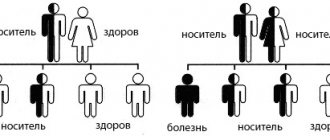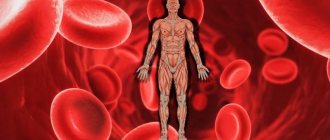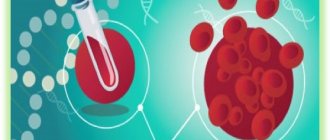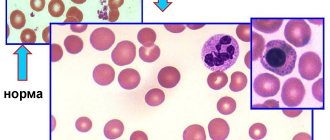Low hemoglobin is not an independent disease. It is the result of an underlying disease, therefore, if anemia is detected in a patient, the doctor is obliged to prescribe a comprehensive examination.
Concepts of pseudoanemia and hidden anemia
Pseudoanemia is the entry of tissue fluid into the bloodstream during the resorption of edema.
Hidden anemia is the result of the loss of a significant part of the fluid composition of the blood due to dehydration (can be caused by diarrhea, vomiting, hyperhidrosis). In this situation, the blood begins to thicken, so laboratory analysis shows that the number of red blood cells and hemoglobin is normal, even if this is not the case.
Severity of anemia
Based on severity, anemia is classified into:
- light. Hemoglobin level is more than 100 g/l, erythrocytes - more than 3 T/l;
- average Hemoglobin level from 66 to 100 g/l, erythrocytes - from 2 to 3 T/l;
- heavy. Hemoglobin level is less than 66 g/l.
Classification of anemia
All anemias manifest themselves differently. Taking into account the cause of the pathological condition and its symptoms, there are four main types:
- posthemorrhagic anemia (caused by chronic/acute blood loss);
- hemolytic anemia (develops due to the destruction of red blood cells). This group includes hereditary hemolytic anemias: - with a lack of glucose-6 phosphate dehydrogenase; - thalassemia; - sickle cell; — Minkowski-Shoffar;
- deficiency anemia (caused by a deficiency of microelements/vitamins/iron, that is, any elements that play an important role in the process of hematopoiesis);
- hypoplastic anemia (results from impaired hematopoiesis in the bone marrow, the most dangerous form).
According to the color indicator of blood, anemia can be:
- normochromic (hemoglobin is normal). This group includes hemolytic and posthemorrhagic anemia;
- hyperchromic (hemoglobin increased). These include folate deficiency and B12 deficiency anemia;
- hypochromic (hemoglobin is low). This refers to thalassemia, iron deficiency and chronic posthemorrhagic anemia.
Based on the diameter of red blood cells, anemia can be:
- normocytic (almost all hemolytic and acute posthemorrhagic anemia);
- megaloblastic (B12-deficiency anemia);
- macrocytic (folate deficiency, hemolytic disease of the newborn);
- microcytic (chronic posthemorrhagic anemia).
Based on the iron content in the blood serum, anemia is divided into:
- normosideremic (acute posthemorrhagic anemia);
- hyposideremic (chronic posthemorrhagic and iron deficiency anemia, thalassemia);
- hypersideremic (hemolytic and B12-deficiency anemia).
Causes of anemia
Common causes of low hemoglobin are:
- large blood loss;
- disruption of the formation of new blood cells;
- activation of pathological processes of blood destruction.
Causes of posthemorrhagic anemia
Acute posthemorrhagic anemia is the result of the loss of a large amount of blood in a minimal period of time. The chronic form of this disease is caused by:
- prolonged blood loss;
- polyps, hernias and stomach ulcers;
- kidney diseases;
- malignant tumor neoplasms;
- uterine bleeding;
- disorders of the blood clotting system;
- liver failure, cirrhosis.
What causes hemolytic anemia
All hemolytic anemias occur if “old” red blood cells begin to destroy faster than new ones can form.
The sickle cell form is caused by the synthesis of a defective hemoglobin molecule. The emerging defective molecules form peculiar crystals that stretch the red blood cell, causing the latter to take on the shape of a sickle. Sickle erythrocytes are non-plastic. It leads to increased blood viscosity and blockage of small blood vessels. With their sharp ends they can destroy each other.
Thalassemia is a hereditary disease. It occurs due to a decrease in the rate of hemoglobin formation. Hemoglobin that is not fully formed is unstable. It resembles small inclusions that give the red blood cell the appearance of a target cell.
Deficiency anemias and their causes
Iron deficiency anemia develops for reasons such as:
- lack of iron/increased need for iron (this is why degree 1 anemia is often diagnosed in premature babies and pregnant women);
- chronic blood loss;
- problems associated with the absorption of iron from the gastrointestinal tract, its transportation and disposal.
B12 deficiency anemia is caused by a lack of vitamin B12. The disease can be caused by poor nutrition (refusal to eat meat) or disruption of the absorption of cyanocobalamin in the gastrointestinal tract (parasites, diseases of the small intestine, stomach). Also, symptoms of B12 deficiency anemia can appear while taking hormonal drugs and anticonvulsants.
Folate deficiency anemia is a consequence of a lack of vitamin B9. It is usually observed in pregnant and lactating women, cancer patients, teenage children, premature newborns, liver disease, alcohol abuse, etc.
Causes of hypoplastic anemia
Hypoplastic anemia is manifested by a decrease in the content of all cells in the blood. External and internal factors lead to such a pathological and life-threatening condition:
- vibration and radiation effects on the body;
- serious injuries;
- taking certain medications;
- ingestion of poisons into the body;
- herpes, fungi, bacteria;
- genetic mutations;
- rheumatoid arthritis, lack of elements involved in hematopoietic processes;
- endocrine diseases, etc.
Main types of anemia
Iron-deficiency anemia
The most common type of anemia is iron deficiency anemia; according to the latest edition of the Oxford handbook of clinical medicine, it affects 14% of women of childbearing age.
Causes of iron deficiency anemia:
— Special diets (for example, vegetarianism)
— Acute blood loss (as a result of wounds and injuries) and chronic (gastrointestinal diseases, ulcers, colon tumors, gastropathy associated with long-term, uncontrolled use of NSAIDs, etc.)
— Malabsorption or poor absorption of iron in the intestine leads to the development of refractory anemia.
— Helminthic infestations, especially in the tropics.
— Pregnancy (if the patient previously had a latent iron deficiency or a special diet).
Diagnosis of iron deficiency anemia anemia
A doctor may suspect anemia by analyzing the patient's complaints (which are often nonspecific and may be a manifestation of other diseases) and the results of the examination, analyzing the condition of the skin, hair, and mucous membranes. During auscultation, the doctor can hear systolic murmur, muffled heart sounds, arrhythmia, and can see changes on the ECG. That's why you shouldn't neglect a doctor's examination! Many people take a general blood test on their own and, having seen the result, start taking iron supplements on their own, without consulting a doctor. You can't do that! It is important not only to cure anemia, increase the level of hemoglobin in the blood, but also to understand the causes of its occurrence and eliminate them. The reasons may be dangerous! (for example, ulcers and tumors of the stomach and intestines).
That’s why, if you ever see reduced hemoglobin or an insufficient number of red blood cells in your blood test, you need to see a doctor as soon as possible!
Anemia during pregnancy
Anemia during pregnancy is often associated with latent iron deficiency before pregnancy, with limited intake of iron and protein from food (toxicosis of 1 half), increased requirements for iron and protein associated with fetal growth.
Therefore, it is more profitable to prepare for pregnancy. Consult a general practitioner, take a general blood test, determine the level of ferritin, serum iron, vitamin B 12, folic acid. If the doctor sees a lack of any vitamins or microelements in the test results, he will immediately prescribe a correction. Because a lack of hemoglobin in the blood of a pregnant woman leads to oxygen starvation of the fetus, increases the number of obstetric complications, such as premature birth, and also increases the risk of developing infection after childbirth!
In order not to worry about the baby, it is better to take care of this before pregnancy. And also take care of yourself. After all, during childbirth, one way or another, blood loss occurs. Therefore, a woman’s anemia may continue after childbirth. She will feel tired, sleepy, but she needs to take care of the baby and breastfeed! Taking iron supplements for nursing mothers is often difficult because An infant develops a rash. That is why it is so important to take care of the prevention of anemia in advance, even before pregnancy!
Hemolytic anemia
Hemolytic anemia is a group of diseases, the common feature of which is increased destruction of red blood cells, which leads to the development of anemia and increased formation of breakdown products of red blood cells, on the other hand, to increased erythropoiesis (formation of red blood cells).
Hemolytic anemias are hereditary (congenital, caused by gene defects) and acquired. This also includes hemolytic anemia of newborns. Hemolytic anemia also occurs as a result of parasitosis such as malaria; it will have a crisis course, with high fever and stunning chills. Therefore, be careful when traveling to areas where malaria is endemic. It is better to consult with an infectious disease doctor in advance and find out how you can avoid infection.
What provokes the development of hemolysis in hemolytic anemia?
— Infections such as parvovirus, rotavirus, norovirus;
- Cold. (with paroxysmal cold hemoglobinuria);
- Taking medications, especially antibiotics, especially on your own, without a doctor’s prescription!
The main symptom that the patient himself or his relatives may notice is jaundice. Sometimes it is dark urine (with paroxysmal hemoglobinuria)
Diagnosis of this type of anemia may require genetic testing.
There are so many types of hemolytic anemia that only a doctor can understand the diagnosis and treatment!
Aplastic anemia
Aplastic anemia is a disease of the hematopoietic system, characterized by inhibition of the hematopoietic function of the bone marrow and manifested by insufficient formation of red blood cells, leukocytes and platelets (panhemocytopenia) or only red blood cells (partial hypoplastic anemia). Aplastic anemia is characterized by severe pancytopenia - anemia, leukopenia, thrombocytopenia and lymphopenia.
It can also be hereditary and acquired. If it is not possible to identify any reasons for the development of aplastic anemia, then such anemia is called idiopathic.
What can lead to the development of aplastic anemia?
— Contact with chemicals (arsenic, aromatic hydrocarbons, in particular benzene, heavy metal salts);
— Ionizing radiation;
— Medicines (NSAIDs, cytostatics, Mercazolil, analgin, chloramphenicol);
— Infectious agents (for example, viruses);
— Autoimmune processes (systemic lupus erythematosus, Sjogren's syndrome).
Therefore, we repeat once again: under no circumstances engage in uncontrolled use of medications! Only by doctor's prescription








